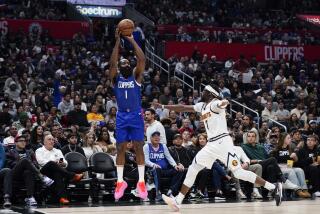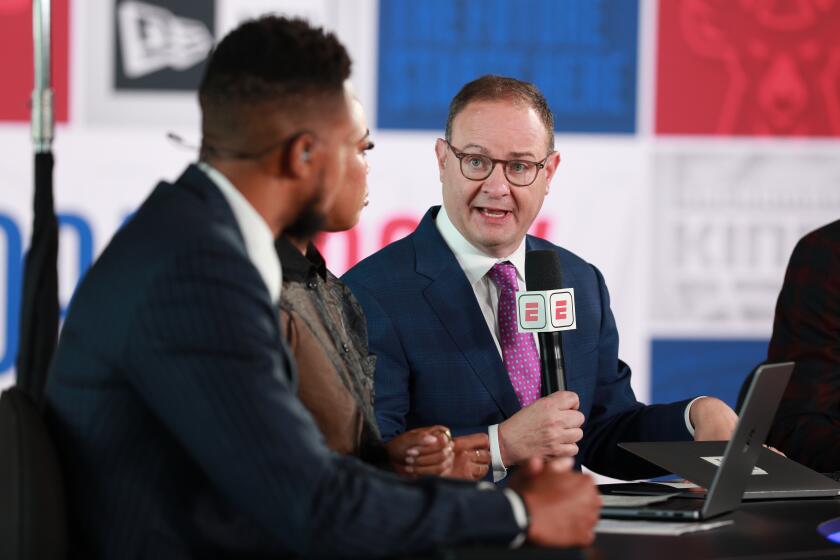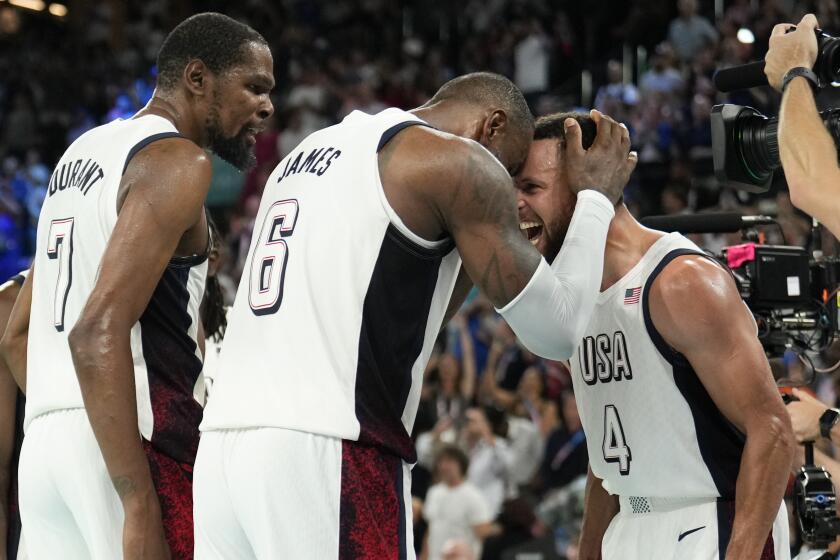The Clippers Thrive in a High-Scoring Environment
The Clippers won a playoff game Wednesday night because they outscored their opponent.
Thanks for the brilliant analysis, J.A. The Times charges 50 cents for this stuff?
Bear with me. When the opponent is the Phoenix Suns this qualifies as news.
On the surface, trying to go point-for-point with the Suns makes as much sense as trying to outdrive Tiger Woods or pitching to Albert Pujols. But the Clippers thought outside the box. They didn’t try to play in slow motion, drag the score down to the pre-shot clock era.
They beat an offensive powerhouse with offensive efficiency. They outslugged the slugger, putting up the type of numbers the Suns are used to posting in a 122-97 victory Wednesday that evened this series at a game apiece.
“We can score and they can score,” Cuttino Mobley said. “We just wanted to pound it inside as much as possible. It worked out for us tonight.”
The Clippers did it with variety, with balance, even some daring and a little bit of fortune and probability swinging their way.
Elton Brand’s 40-point effort didn’t get it done in the first game, negated in part by Mobley’s three-point disappearing act. But Mobley was heard throughout the Valley of the Sun on Wednesday, his 23 points matching backcourt mate Sam Cassell and providing a nice supplement to Brand’s 27 points. Chris Kaman, another silent partner in Game 1, led the Clippers’ 57-26 rebound advantage with 16.
This series will be about offense. The Clippers can initiate their defense by playing smart offense. The Clippers cut their turnovers from 15 in Game 1 to 12 in Game 2, having only seven through the first three quarters. They emphasized the inside game, outscoring the Suns, 58-36, in the paint.
Yes, the Clippers played smarter defense, did a better job of staying in front of their men. The Suns were held under 100 points for the fourth time in the playoffs, all Phoenix losses. That’s what the Clippers’ coach and players raved about afterward.
“It’s defense,” Brand said. “That’s all it is. That’s what did it for us.”
But the Clippers controlled the game even when the Suns were on a 100-point pace with 51 points in the first half.
The Clippers did a little gambling. They crashed the offensive boards and risked giving the Suns a numbers advantage the other way if the Clippers didn’t get the rebound. Instead they grabbed exactly half of their first 36 missed shots and 19 of 41 overall. You jump at 50-50 odds in Las Vegas, and the same applies in the NBA playoffs.
The difference in the game was second-chance points. The Clippers outscored Phoenix, 30-6, in that category, accounting for 24 of the 25-point margin of victory.
Brand and Kaman led the way, but Mobley, Shaun Livingston and Vladimir Radmanovic chipped in. Cassell even had an offensive rebound (although it did bounce on the floor first).
The Clippers also dared to pull up for jump shots in transition, the kind of shots that better go in. Cassell went one-on-three for a layup. He made it, which is why he has Mike Dunleavy’s permission to do that.
Shaun Livingston’s still working with a learner’s permit, not the full driver’s license. He doesn’t get the same liberties. He rushed a couple of plays during the Clippers’ fourth-quarter swoon in Game 1. So this time he played it a little safer, slowed it down and assessed the situation. He had one of the least impressive stat lines of the night -- eight points and one assist -- but he made as many good decisions as anyone on the court. He didn’t have a turnover.
The Suns light up when you miss or turn the ball over, because it’s a bonus for them. They’re not trying to shut down an opponent. They’re even OK if the other team scores two points, because the Suns figure they’ll come down and make a three.
Everyone says you can’t win with that approach in the playoffs, but the Suns have won three of four playoff series since Steve Nash arrived and turbocharged the offense. They don’t get enough credit for imposing their style on games.
But there’s a danger in relying so heavily on the three-point shot, and in Game 2 the averages swung in the Clippers’ favor. The Suns made 44% of their three-pointers in Game 1, a great night even for the team that led the league in three-point shooting this season. But the Suns shot only 39.2% in the regular season. Wednesday night they swung about 5% the other direction, hitting 34.6% (nine for 26).
Suddenly the confidence wasn’t there. Trailing big in the second half, Shawn Marion passed up an open three and dribbled in. He dished to Tim Thomas. Thomas made the shot, but the Clippers would rather give up a two-pointer with more time off the clock than an early three-pointer.
Teams will find their typical level through the course of a series. The good news for the Clippers is they hung in the game when the Suns made their three pointers in Game 1 and pounded them when they missed in Game 2.
“We can’t relax,” Dunleavy said. “We have to hold court when we go home.
“They get a hot hand, it’s hard to throw water on that fire. We don’t take anything for granted. In this series, anything can happen.”
We just saw it: the Clippers managed to outscore the Phoenix Suns.
J.A. Adande can be reached at j.a.adande@latimes.com. To read more by Adande, go to latimes.com/adandeblog.
More to Read
Get our high school sports newsletter
Prep Rally is devoted to the SoCal high school sports experience, bringing you scores, stories and a behind-the-scenes look at what makes prep sports so popular.
You may occasionally receive promotional content from the Los Angeles Times.




